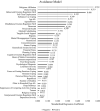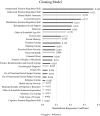Adhering to COVID-19 health guidelines: Examining demographic and psychological predictors of adherence
- PMID: 34032383
- PMCID: PMC8239601
- DOI: 10.1111/aphw.12284
Adhering to COVID-19 health guidelines: Examining demographic and psychological predictors of adherence
Abstract
The effort to limit the spread of the coronavirus (COVID-19) has relied heavily on the general public's compliance with health guidelines limiting social contact and mitigating risk when contact occurs. The aim of this study was to identify latent variables underlying adherence to COVID-19 guidelines and to examine demographic and psychological predictors of adherence. A sample of US adults (N = 1,200) were surveyed in late April to mid-May 2020. The factor structure of adherence was examined using exploratory factor analysis. Machine learning regression models using elastic net regularization were used to examine predictors of adherence. Two factors characterized adherence: avoidance and cleaning. Elastic net models identified differential demographic and psychological predictors of these two forms of adherence. Religious affiliation, denial coping, full-time employment, substance use coping, and being 60 or older predicted lower avoidance adherence. Behavioral and mindfulness emotion regulation skills, agreeableness, and Democrat political affiliation predicted greater avoidance adherence. For cleaning adherence, interpersonal and behavioral emotion regulation skills and conscientiousness emerged as strong predictors of greater cleaning. Efforts to promote compliance with COVID-19 health guidelines may benefit from distinguishing avoidance and cleaning adherence and considering predictors of each of these aspects of adherence.
Keywords: COVID-19; health adherence; health behaviors; machine learning.
© 2021 International Association of Applied Psychology.
Conflict of interest statement
No conflict of interest has been declared by the authors.
Figures
Similar articles
-
Spring 2020 COVID-19 Surge: Prospective Relations between Demographic Factors, Personality Traits, Social Cognitions and Guideline Adherence, Mask Wearing, and Symptoms in a U.S. Sample.Ann Behav Med. 2021 Jun 28;55(7):665-676. doi: 10.1093/abm/kaab039. Ann Behav Med. 2021. PMID: 33991096 Free PMC article.
-
The Role of Illness Perceptions, Coping, and Self-Efficacy on Adherence to Precautionary Measures for COVID-19.Int J Environ Res Public Health. 2020 Sep 8;17(18):6540. doi: 10.3390/ijerph17186540. Int J Environ Res Public Health. 2020. PMID: 32911779 Free PMC article.
-
Predicting attitudes towards easing COVID-19 restrictions in the United States of America: The role of health concerns, demographic, political, and individual difference factors.PLoS One. 2022 Feb 23;17(2):e0263128. doi: 10.1371/journal.pone.0263128. eCollection 2022. PLoS One. 2022. PMID: 35196316 Free PMC article.
-
Predictors of attitudes and adherence to COVID-19 public health guidelines in Western countries: a rapid review of the emerging literature.J Public Health (Oxf). 2021 Dec 10;43(4):739-753. doi: 10.1093/pubmed/fdab070. J Public Health (Oxf). 2021. PMID: 33704456 Free PMC article. Review.
-
Personality dimensions and disorders and coping with the COVID-19 pandemic.Curr Opin Psychiatry. 2022 Jan 1;35(1):73-77. doi: 10.1097/YCO.0000000000000755. Curr Opin Psychiatry. 2022. PMID: 34855697 Free PMC article. Review.
Cited by
-
Associations between Lifestyle Changes and Adherence to COVID-19 Restrictions in Older Adults with Hypertension.Int J Environ Res Public Health. 2022 Jun 26;19(13):7853. doi: 10.3390/ijerph19137853. Int J Environ Res Public Health. 2022. PMID: 35805511 Free PMC article.
-
The Mental Health Paradox of COVID-19 Prevention: Adherence, Fatigue, and Depression in a Longitudinal Perspective.J Prim Care Community Health. 2025 Jan-Dec;16:21501319251334207. doi: 10.1177/21501319251334207. Epub 2025 Apr 15. J Prim Care Community Health. 2025. PMID: 40233310 Free PMC article.
-
The experiences and impact of the COVID-19 pandemic on young carers: practice implications and planning for future health emergencies.Child Adolesc Psychiatry Ment Health. 2024 Jan 3;18(1):2. doi: 10.1186/s13034-023-00697-6. Child Adolesc Psychiatry Ment Health. 2024. PMID: 38172971 Free PMC article.
-
Mental health and the overall tendency to follow official recommendations against COVID-19: A U-shaped relationship?PLoS One. 2024 Jun 25;19(6):e0305833. doi: 10.1371/journal.pone.0305833. eCollection 2024. PLoS One. 2024. PMID: 38917072 Free PMC article.
-
Did Mindful People Do Better during the COVID-19 Pandemic? Mindfulness Is Associated with Well-Being and Compliance with Prophylactic Measures.Int J Environ Res Public Health. 2022 Apr 21;19(9):5051. doi: 10.3390/ijerph19095051. Int J Environ Res Public Health. 2022. PMID: 35564450 Free PMC article.
References
-
- Aguinis, H. , Villamor, I. , & Ramani, R. S. (2020). MTurk research: Review and recommendations. Journal of Management, 47(4), 823–837. https://doi.org/10.1177%2F0149206320969787
-
- Al‐Hasan, A. , Yim, D. , & Khuntia, J. (2020). Citizens’ adherence to COVID‐19 mitigation recommendations by the government: A 3‐country comparative evaluation using web‐based cross‐sectional survey data. Journal of Medical Internet Research, 22(8), e20634. 10.1016/j.jiph.2020.05.021 - DOI - PMC - PubMed
-
- Alloy, L. B. , & Riskind, J. H. (2006). Cognitive vulnerability to emotional disorders. Routledge.
MeSH terms
Grants and funding
LinkOut - more resources
Full Text Sources
Other Literature Sources
Medical
Miscellaneous



